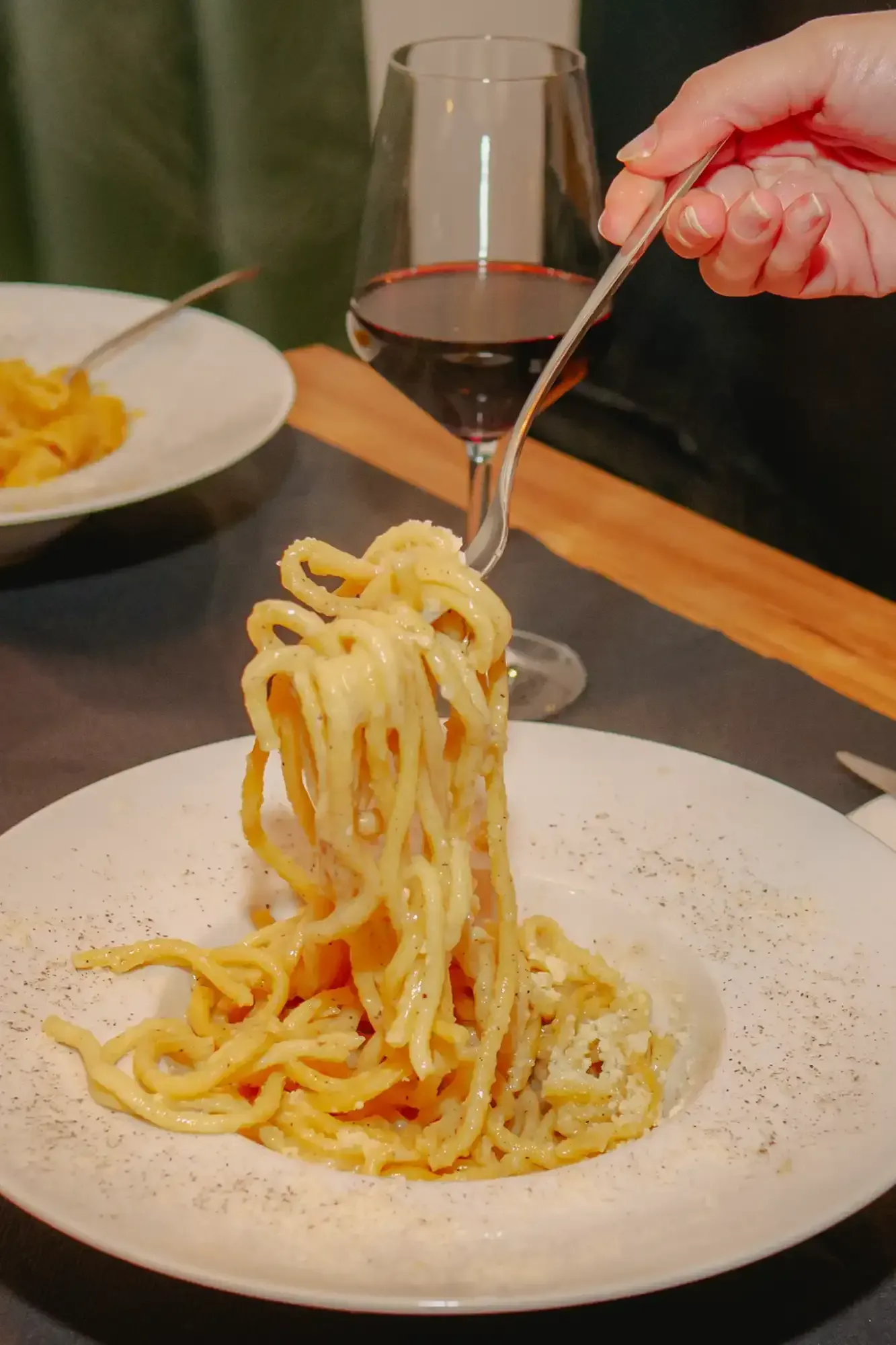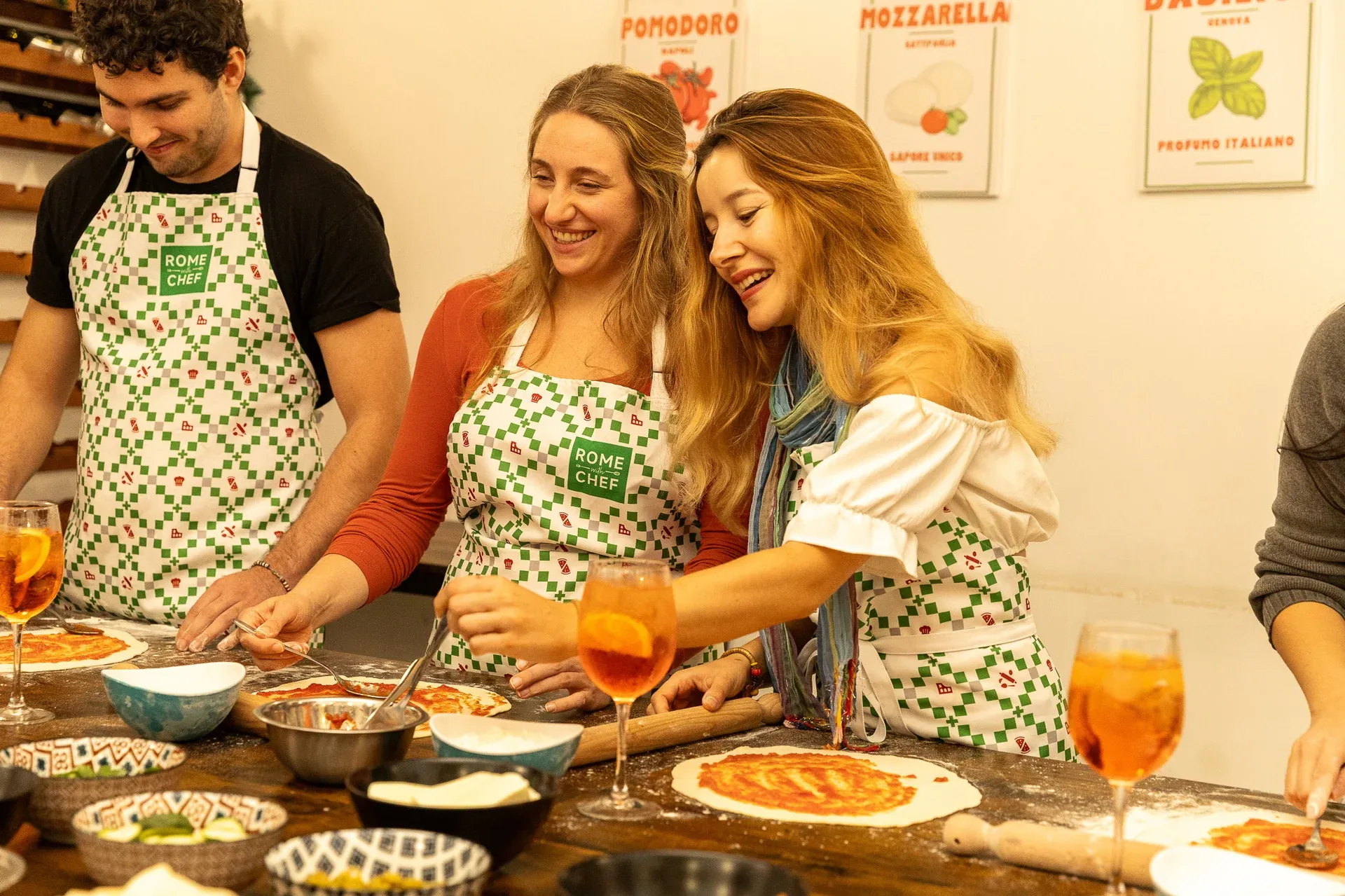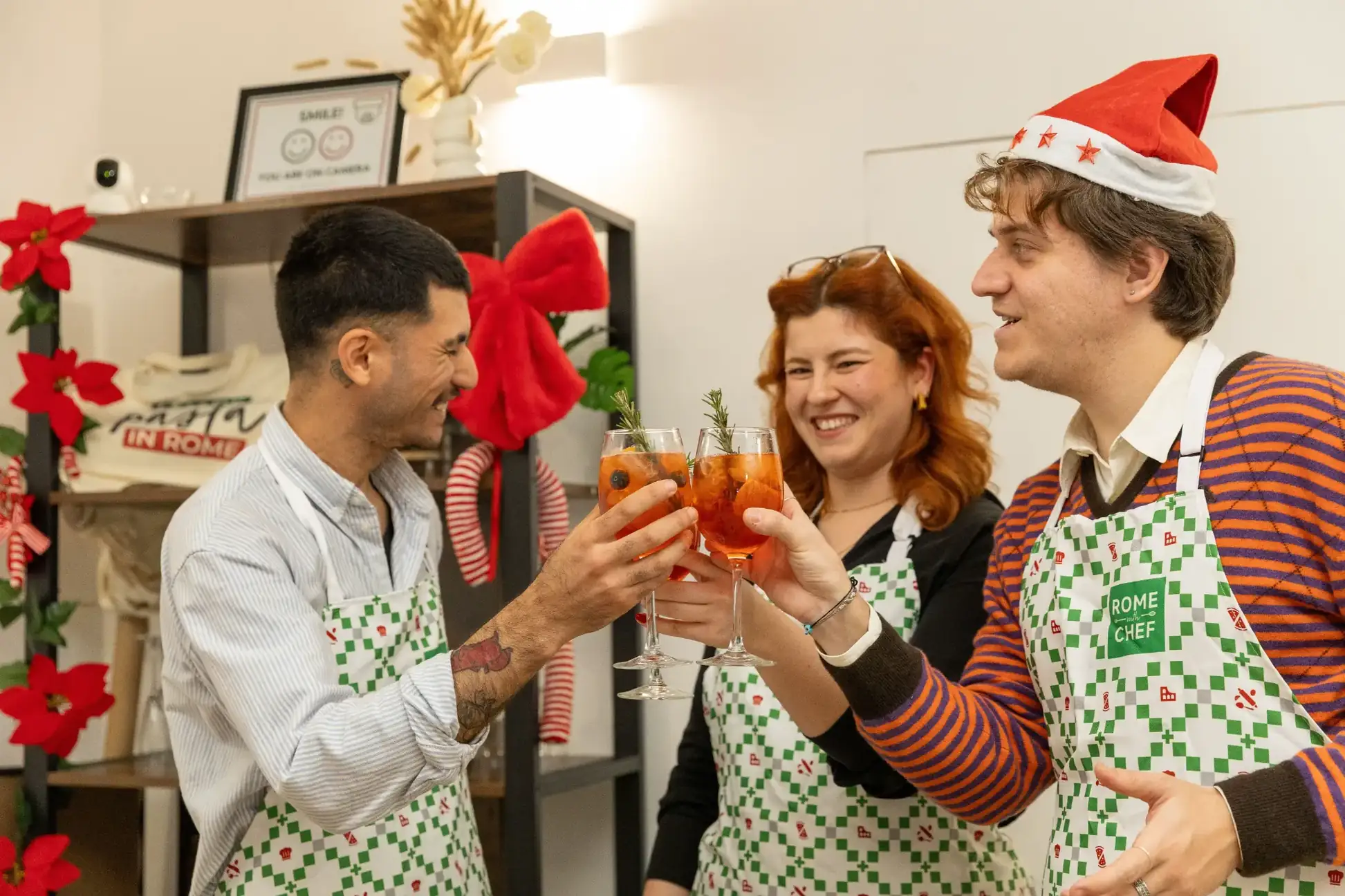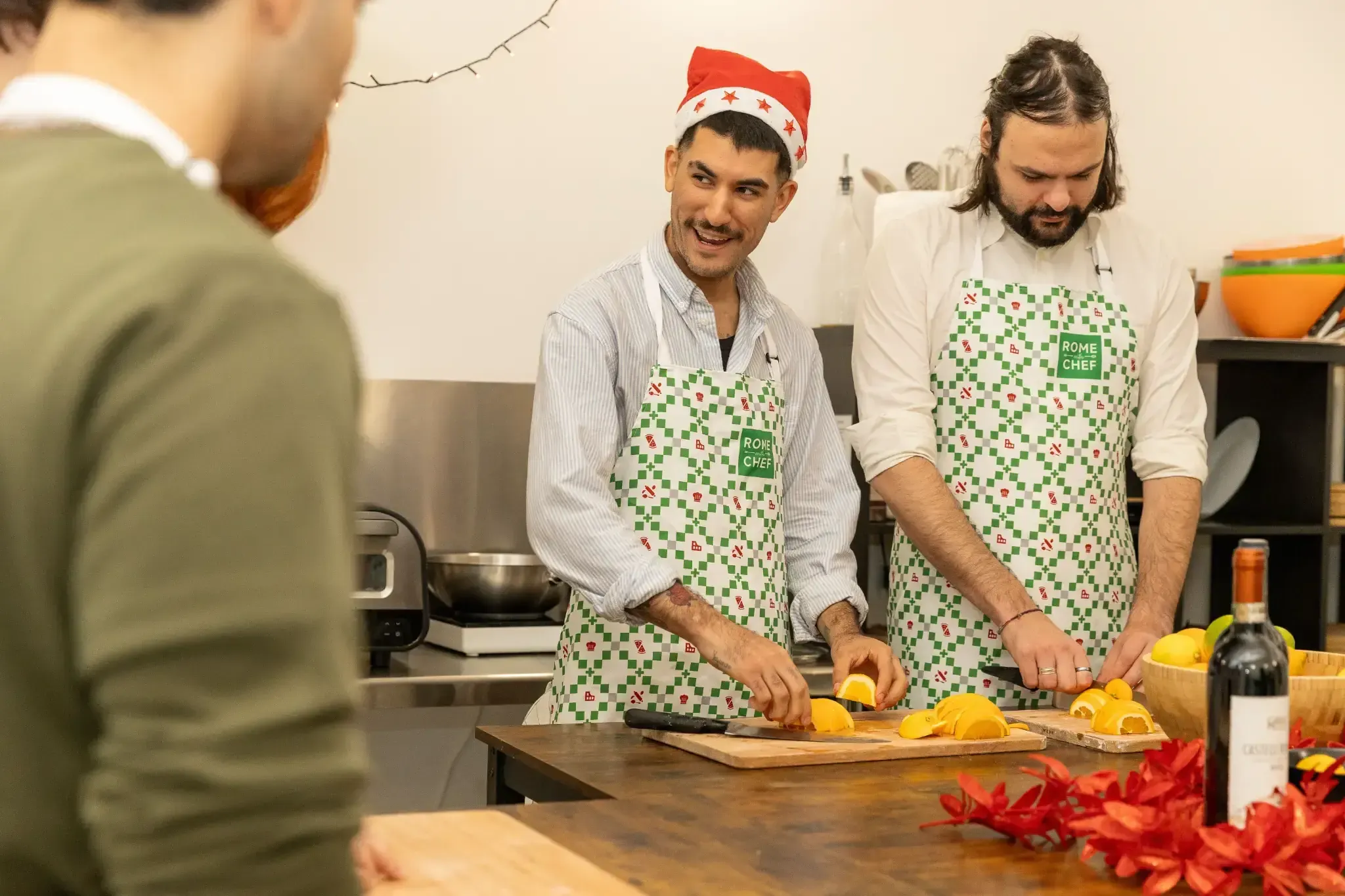


.webp)
If you’re hungry in the Eternal City, you’re in good hands. Rome is one of the world’s greatest food capitals, claiming top spot in the Traveller’s Choice Award for 2025. This should come as no surprise. Rome is home, after all, not only to crisp “Roman-style” pizza, rich pasta classics like carbonara and amatriciana, and creamy, dreamy gelato but so much more besides.
Yet Rome is also a city that thrives on tourism. And where tourists travel, tourist traps spring up. Which brings me onto why you should trust me and the recommendations I’ll be providing in this guide. I’m a British national who’s been living in Rome for six years (and in Italy for eleven), working across tourism, travel writing, and food experiences. I’ve eaten in more trattorie than I can count, sampled every Roman dish worth knowing (and a few that absolutely weren’t), and spent years learning what Roman cuisine is really all about.
What follows is the guide I wish every traveller had before landing in Italy’s capital – so they can eat like a local and avoid the dreaded tourist traps.
Ask a Roman what their city is famous for and you’ll get a passionate lecture punctuated by nostalgia, hand gestures, and possibly a plate of pasta. Roman food is bold, unfussy, and deeply rooted in the city’s working-class traditions. Expect:
Below, we break down each food category — what it is, why it’s important, and where to try it.
Roman breakfasts are simple affairs. No bacon and eggs, no stacks of pancakes — just a light, satisfying sugar-and-caffeine hit to set you up for the next few hours. Most Romans stand at the counter, down their espresso in a single determined gulp, before saying their “ciao-s” to the bar staff and disappearing off to work.
Full disclosure: I wish that Romans did load up more on carbs and fibre at breakfast. Then they might not act like complete caffeinated psychopaths behind the wheel on their way to work. But I digress…
The most common breakfast pairing is a cornetto — a sweet pastry, sometimes filled with jam (marmellata), crema (pastry cream), pistacchio or Nutella — and caffè. You may have heard on social media that drinking cappuccino after 11am is some kind of crime, but this is largely rubbish. The real cardinal sin is ordering it with a meal.
Each neighbourhood will have its own locally patronised bars, but the centre has some excellent long-established coffee bars. Below are two of my favourite coffee bars in Rome’s historic centre. For a more complete list, where I spill the beans on all things coffee, check out my guide to the best coffee in Rome.
Sitting just steps from the Pantheon, La Casa del Caffè Tazza d’Oro may look like a tourist hotspot — but don’t be fooled. Romans adore this place, and with good reason. The coffee is rich, punchy, and served with the no-nonsense efficiency you’d expect from a true Roman institution. Pair your cappuccino with a sweet maritozzo filled to the brim with whipped cream for an indulgent start to the day.
Elegant and unmistakably Neapolitan, Gran Caffè La Caffettiera is the go-to for southern Italian coffee culture at its finest. Their pastries are the stars of the show: rum-soaked babà and perfectly flaky sfogliatelle filled with ricotta. Netflix subscribers may recognise it, too — it recently featured in Ripley as Tom Ripley’s Roman coffee spot of choice.
Street food in Rome is a revelation: simple, inexpensive, and obscenely delicious. Below are the Italian capital’s heavy hitters — each one worth sampling at least once.
Pizza al taglio — pizza sold by the slice — might just be Rome’s favourite fast food. Baked in large rectangular trays and displayed on bakery counters, it’s cut and priced by weight, making it as flexible as it is delicious. Ordering is delightfully hands-on: point to the slice that catches your eye, watch as the staff slide the knife along the tray, and say “basta” when the portion is just right.
One of the city’s most popular spots is Alice (pronounced Ali-chay), a chain that consistently delivers thin, crispy slices topped with all sorts of inventive combinations. With around 60 locations across Rome, you’re never far from a quick, tasty bite.
Deep-fried rice balls stuffed with mozzarella and ragù. Pull one apart and you’ll get that signature mozzarella stretch — supplì al telefono. Supplì Roma is a great local spot to try this Roman classic, offering a wide range of fillings at €1.50 – €3 each. You can also order supplì at any Roman pizzeria, as many Romans start their meal with something fried.
Trapizzino is one of the newest stars of Rome’s street food scene, bursting onto the scene in 2008. It’s a brilliant hybrid of tramezzino (the soft, triangular Italian sandwich) and pizza al taglio (sliced pizza). Think of it as a warm, triangular pocket of pizza dough stuffed with classic Roman dishes like pollo alla cacciatora (hunter’s chicken), polpette (meatballs simmered in tomato sauce), or for the more adventurous lingua in salsa verde (ox-tongue in green sauce).
Salted cod dredged in batter and fried to golden perfection. Light, flaky, and dangerously addictive. There are two places I’d recommend you try it. The first is Dar Filettaro, a historic establishment not far from Campo de' Fiori that has been serving delicious baccalà for generations as street food on the go or with sides like potatoes or puntarelle soaked in olive oil and anchovies. Dar Filettaro is only open from 5 pm to 10:30 pm and is closed on Sundays, so time your visit accordingly.
Testaccio Market’s Food Box also serves up some brilliant baccalà as well as most other street food mentioned in this article. Expect to pay between €5 to €8 per fillet.
Read more on Roman street food by clicking the link below.
We’ve all heard of at least one of cacio e pepe, carbonara, amatriciana and gricia. But did you know that they originated in (or around) the Italian capital? Here’s a closer look into each one.
Cacio e pepe is minimalist brilliance, and the most faithful representation of “la cucina povera romana” – or simple Roman cooking. It consists of little more than salty pecorino romano cheese and ground black pepper, mixed into a sauce of salted pasta water flavoured by long, thin noodle pasta like spaghetti or bucatini. In recent years, it has taken the world by storm. It featured on 48% more menus in the US by the end of 2022 than it did four years earlier, and has infused and inspired recipes beyond pasta, including spreads, flatbreads and pizzas.

Da Felice is widely regarded as the best place for cacio e pepe in Rome. Maybe it once was, but if you want my honest opinion, it’s no longer even in the top 10. Instead, I’d recommend Piatto Romano, another restaurant in the authentic working-class district of Testaccio. Their cacio e pepe with Madagascar pepper is simply divine. If you’d like to learn how to make Cacio e Pepe in Rome, you can do so on our Private Pasta & Tiramisù Cooking Class.
You won’t find cream in a real Roman carbonara. Authentic carbonara relies on just a handful of ingredients: guanciale (cured pork cheek), pecorino romano, and raw egg yolks. As the hot pasta hits the bowl, the rendered pork fat, sharp cheese, and silky yolk emulsify into a glossy, velvety sauce that clings beautifully to spaghetti, fettuccine, or rigatoni.
It’s no surprise that carbonara is the star of our Spritz & Spaghetti Cooking Class — it’s the dish guests are always most excited to master.
There are plenty of contenders for the best carbonara in Rome, but in terms of atmosphere you’ll never eat anywhere like Flavio al Velavevodetto. The restaurant is hewn within a man-made mound of ancient pottery shards called Monte Testaccio, situated not far from the River Tiber. Oh, and Flavio has won awards for the Best Carbonara Pasta in Rome.
Originally from the hilltop town of Amatrice, about 150 km northeast of Rome, amatriciana is a hearty, tomato-rich pasta sauce — the messiest (but definitely the most family-friendly) of the four Roman classics to make at home.
A traditional amatriciana needs only three main ingredients: guanciale (cured pork cheek), tomatoes, and pecorino romano, brought together with a generous pinch of salt, pepper, and, if you like a little kick, some chilli flakes. Simple, bold, and unmistakably Roman.
I love Rione 13 in Trastevere. I first went there with a tour group and was not expecting much, but their rigatoni all’amatriciana honestly blew me away.
Fancy trying to make amatriciana yourself? Here’s an excellent recipe.
Gricia is what happens when you strip the egg from a carbonara (or slip some pork cheek into a cacio e pepe). It’s the least internationally famous of the four Roman pastas, but ask a local and they’ll tell you it’s the best — Romans have a soft spot for recipes that keep things simple, bold, and ingredient-forward.
Da Bucatino in Testaccio does a genuinely stunning gricia con carciofi (gricia with artichokes). But for the best, no-nonsense, bare bones gricia, take a taxi to Osteria Bonelli to the east of the city centre.
Fancy trying to make gricia yourself? Here’s an excellent recipe.
Pizza is as quintessentially Italian as designer sunglasses, Aperol Spritz, and devastatingly poor parking. But pizza is also divisive, with Romans, Neapolitans, and Sicilians arguing among themselves about who invented it first (Neapolitans) and whose version is best (something I won’t commit to paper for fear of… repercussions).

Freshly baked pizza al taglio from one of our favourite pizza places in Rome
Roman-style pizza is thin and crispy, owing to its incorporation of olive oil into the dough, and its sauce and toppings are generously spread to nearly the edges of the crust. Roman-style pizza is baked rapidly, for about three minutes at around 700°F. But because the base is so much thinner, crispier, and self-supporting, it’s structurally different to a Neapolitan pizza. If you pinch a slice at the edges and hold it up, you’ll find it never sags in the centre, unlike the softer pizza napoletana.
Check out my complete guide below to the best pizzerias in Rome.
Saltimbocca alla Romana is one of Rome’s most beloved secondi — a simple, elegant dish whose name literally means “jumps in the mouth,” and it does exactly that. Tender veal is topped with earthy sage leaves and delicate prosciutto, then lightly cooked in butter and white wine until everything melds into a silky, fragrant sauce. The result is savoury, aromatic, and melt-in-the-mouth perfection.
For one of the best versions in the city, head to Armando al Pantheon, a historic trattoria just steps from the Pantheon. Known for its faithful renditions of classic Roman dishes, Armando serves a saltimbocca that’s beautifully balanced — rich but not heavy, traditional without feeling dated, and cooked with the kind of precision that only decades of practice can.
Coda alla vaccinara is Rome’s great slow-cooked masterpiece — a rich, velvety oxtail stew that traces its origins back to the city’s old butcher community in Testaccio. The dish is simmered for hours with tomato, celery, wine, and a hint of bittersweet cocoa, transforming humble ingredients into something deeply comforting and wonderfully complex. The meat becomes so tender it slips off the bone, and the sauce is the kind you’ll want to mop up with half a loaf of bread.
For the definitive version, make your way to Checchino dal 1887 in Testaccio. This historic trattoria has been cooking coda for more than a century and remains the benchmark for traditional Roman offal dishes. Their recipe is slow, soulful, and utterly authentic — the sort of coda that makes you understand why Romans have cherished this dish for generations.
Pollo alla Romana is Roman comfort cooking at its most nostalgic — a colourful stew of chicken simmered slowly with sweet peppers, tomatoes, garlic, and a splash of white wine. Traditionally eaten in summer, especially around Ferragosto, it’s a dish that tastes like long lunches, warm evenings, and family tables. The peppers soften into the sauce, the chicken becomes beautifully tender, and the whole thing has a rustic, home-cooked charm that’s impossible not to love.
For a deliciously faithful version, head to Ristorante Virginiae — one of the only places I’d eat near Piazza Navona. This cosy trattoria specialises in classic Roman dishes done right, and their pollo alla romana is exactly what it should be: simple, generous, and full of bold, familiar flavours.
Trippa alla Romana is one of the city’s most traditional — and most proudly Roman — dishes. Made from slow-cooked tripe simmered in a rich tomato sauce with mint and pecorino romano, it’s a testament to Rome’s “cucina povera” roots, where every part of the animal was transformed into something comforting and delicious. The texture is tender, the sauce fragrant and hearty, and the finishing shower of pecorino gives it that unmistakable Roman kick.
If you want to try a truly standout version, make your way to Osteria della Trippa in Trastevere. As the name suggests, this cosy osteria takes tripe seriously, serving a wonderfully authentic rendition that even sceptics end up loving. It’s the perfect spot to experience a dish Romans have cherished for generations.
Winner of a Viator Experience Award in 2024, our Rome Food Tour steers you clear of the tourist traps and gives you priority service to a generous spread of Roman cuisine.
Your local guide will lead you and a small group of fellow food lovers through the medieval neighbourhood of Trastevere, introducing you to porchetta, pizza bianca, street food like supplì, several Roman pasta dishes, main courses, and artisan gelato — with plenty of wine to pair with your tastings.
Spaces fill up fast. Secure your spot today.
Book your Small-Group Rome Food Tour
Book your Semi-Private Food Tour with Premium Menu
Treat Yourself to a Fully Private Rome Food Tour
These tours combine storytelling, tradition, and hand-picked dishes for an unforgettable culinary experience.
Carpe Diem Tours offers a range of cooking classes in Rome that will make you the undisputed hero of dinner parties for friends and family back home.
Join our top-rated Pasta & Tiramisù Cooking Class and learn how to make hand-cut fettuccine and the creamiest coffee-soaked tiramisù. You’ll be welcomed with a glass of prosecco, meet your fellow food lovers, and dive straight into mixing, kneading, rolling, and slicing your fresh pasta dough — no machine required.
Finish the experience with a two-course meal of your homemade pasta and tiramisù paired with local wine, plus recipes emailed to you so you can recreate everything at home.
Looking for something more exclusive? Choose our Private Pasta & Tiramisù Class.
Perfect for fun-loving foodies, our Pizza & Cocktails Class blends hands-on pizza making with a lively Italian mixology demo. Learn the secrets behind Roman-style thin, crispy dough as you knead, roll, top, and bake your own pizza under the guidance of a friendly local chef.
Between steps, sip your way through an Aperol Spritz and Campari Spritz demo, then sit down to enjoy your homemade pizza with a Limoncello Spritz (non-alcoholic options available). Recipes are sent via email so you can recreate the magic at home.
Secure your spot on our Pizza & Cocktails Class in Rome!
This hands-on cooking class combines cocktail-making and pasta-making in one fun, boozy, laughter-filled evening. Over three hours, you’ll mix and taste Aperol Spritz, Campari Spritz, and Limoncello Spritz (or prosecco if you prefer), before learning how to make homemade fettuccine from scratch.
Your expert local chef will share cultural insights, pasta-making secrets, and answer the eternal question of whether carbonara contains cream (spoiler: absolutely not). Finish by enjoying your fettuccine with either cacio e pepe or carbonara sauce.
This class is strictly 18+, so you won’t be sharing the space with families or kids. Let loose, get a little tipsy, and live la dolce vita.
Secure your spot on our Spritz & Spaghetti Cooking & Cocktail Class

No headings found in content.

From December 1st until January 6th, our pizza class gets a merry makeover: mix your own seasonal spritz and indulge in a classic Italian Christmas dessert.
This isn’t your average elementary school pizza party; this is Rome, and we’re turning up the heat! Just ten minutes from the Colosseum, our high-energy cooking class is where pizzas fly and glasses are raised high.
In this dough-lightful evening experience, you’ll toss, top, and toast your way through a night of pizza-making, drink-sipping, and full-on Roman revelry. Ready to make your very own pizza? You’ll get a slice of pizza history from Rome and beyond, and a charismatic local chef will show you how to work the dough like a pro.
Roll, knead, and spread the dough before topping it off with everything your heart desires, except pineapple of course, we've got to stick to the rules. Then, as the dough rises, so does the mood because you'll get a crash course in Italian mixology. Sip on traditional Italian cocktails like Aperol and Hugo Spritz and socialise with your fellow chefs while your pizza bakes to Roman perfection.
Then, when everything is ready, it’s time to eat! You’ll dine like the Italians over a homemade pizza while continuing to sip on a Limoncello Spritz until your heart's content. You know the saying, when life gives you lemons, we turn it into a toast.
Whether you’re coming with friends, your amore, or are ready to make new pizza-loving pals, this isn’t just dinner, it’s a hands-on, wine-filled, flour-dusted party you’ll never forget.
So come hungry, bring your appetite for fun, and let’s raise a glass (and a pizza peel) to the tastiest night of your Roman holiday!

We’re spinning up festive flavours, Italian-style! From December 1st until January 6th, our pasta and tiramisu class gets a holiday twist, complete with mulled wine magic and made-from-scratch fun.
Learn to cook like an Italian in this small group pasta & tiramisù cooking class that gives you mastery over the country’s best-loved classics. Over the course of three fun-filled hours, you’ll enjoy the expert guidance of our fluent professional chef and get hands on recreating real Roman recipes, culminating in a well-deserved dinner and dessert.
Situated in our centrally situated air-conditioned cooking school, your interactive class will give you the true sense of an Italian nonna’s loving kitchen. Led by an enthusiastic and knowledgeable English-speaking chef, our cooking masterclass is perfect for kids and adults, beginners and experts.
Savoiardi (ladyfingers) are gently dipped in rich coffee before being layered with dollops of delicately mixed eggs and panna (cream). Finished off with a sprinkle of cocoa, these delicious desserts are set aside to rest in time for an after-dinner energy boost. In fact, the espresso within a tiramisù is what gives it a name that translates literally as “pick me up”!
Rolling up our sleeves, here is where we channel our inner nonna. Mixing, kneading, rolling, and shaping our fresh pasta from scratch will work up a sweat but result in elegant end products. We will then combine these carefully crafted creations with the flavours of the season and locality; be it twangy cacio e pepe or creamy carbonara.
How else to conclude your cooking class than by fully indulging in your culinary creations! Celebrate your accomplishment with family-friendly company, a gorgeous setting, and a glass of local wine or prosecco.
Whether returning a culinary maestro or a self-proclaimed novice, you’ll be sure to take the memories home with you and ruling your dinner parties back home!

Our Trastevere Food Tour just got an upgrade—smaller groups, bigger flavour, and a deeper connection to real Roman food culture. With only 6 people per group, you’ll enjoy personalised attention from your guide and a more intimate experience with fellow food lovers. You’ll savour the best of Trastevere at a relaxed pace, no rushing, no waiting—just excellent food, fast service, and meaningful stories behind every bite.
We’ve also upgraded the menu to include a second course with your choice of a hearty meat or veggie main, made from locally and sustainably sourced, pesticide-free ingredients. You’ll dine at intergenerational, family-run eateries that have been part of the Trastevere community for decades, places where recipes are passed down like heirlooms and “slow food” is a way of life. Oh, and did we mention that you'll also get limoncello? What could be better than that!
Ready for a delectable experience in Rome? Prepare for an unforgettable adventure through one of the city's trendiest (and tastiest!) neighbourhoods, at a perfect pace for everyone in your group.
Please note that the places we visit and the food we try depends on the season. We also have vegetarian options available at every stop!
This is a sustainable tour, meaning part of the profit goes towards reforestation
Summer’s coming! We ask our guests to bring a reusable water bottle to refill along our route to stay hydrated and also help us reduce waste.

Twirl, sip, and soak up the seasonal cheer, because from December 1st to January 6th, we’re giving our usual class a holly-jolly glow-up. You’ll stir up a limited-edition cocktail packed with Yuletide spirit and finish with a classic Italian Christmas treat.
Did someone say Spritz? Discover the flavours of Rome on our Spritz and Spaghetti Class. Our centrally located kitchen is where you’ll learn everything you need to mix traditional Italian cocktails, and perfect the art of making fresh pasta. This is the only cooking class of its kind in Rome – a perfect blend of food, friends, and tipsy fun. So come join us and see what all the fuss is about!
Our team will welcome you and your small, intimate group with a mixology demo making Italy’s best-loved drink: Aperol Spritz. You’ll then get started on your hands-on pasta-making lesson led by a fun-loving, fluent professional chef before making a Hugo Spritz.
Your professional chef will guide you every step of the way – from kneading the dough to cutting the pasta. You’ll also be making a creamy carbonara sauce to coat your fresh pasta (vegetarians can try out another Roman classic of cacio e pepe). Travelling is all about meeting new people. At the end of this cooking class, you’ll dine on what you’ve made with a glass of Limoncello Spritz to wash it all down.
Book now and start making memories.
.webp)
Feed your curiosity as you please your palate on this indulgent Rome Food Tour! There's a reason our tour is multi-award-winning, and it's because we give you an all-access pass to savouring the Eternal City, stress-free. With everything pre-arranged, you’ll bypass the crowds as you taste your way through Rome; no queues, no guesswork—just authentic Roman cuisine. This fun (and filling) food tour gives you and a group of fellow foodies a taste of the city's culinary treasures, from local delicatessens and pizzerias to traditional trattorias and restaurants, you'll try all the authentic spots that the locals keep to themselves but your guide will reveal to you.
Our award-winning Rome food tour takes place in Trastevere, Rome's most traditional medieval neighbourhood. While the area is renowned for its buzzing nightlife and world-class cuisine, just like the rest of Rome, this neighbourhood also has its fair share of tourist traps. That's why we have teamed up with the places that keep to traditions and serve food for locals.
Because holidays are too short to eat badly, right?
This food tour in Rome will treat your tastebuds to at least 10 different tastings (vegetarian options available!) perfectly paired with a selection of local wines or non-alcoholic beverages for sober travellers. Try crispy Roman-style pizza by the slice, savoury supplì, and the best gelato in the city. Experience is more than just simply trying local cuisine, it's a glimpse inside the Roman kitchen—discovering the delicacies, the diet and the cultural dos and don’ts.
While you taste your way through the capital on this food tour; Rome will fully open up as you’ll also discover the process, meet the makers, and truly understand why Italian cuisine is considered the best in the world. So book your spot on our Rome Food Tour today and get ready for a true taste of the capital!
Please note: the places that we visit and the food that we try depend on the season.
Looking for a more intimate local experience with no strangers? We now offer an exclusive semi-private Rome food tour for groups of 6 or fewer.
This is a sustainable tour, meaning part of its profits go towards reforestation and other sustainable projects. We also ask all of our guests to bring a reusable water bottle to refill at one of the water fountains along our route to stay hydrated and help us reduce waste.
**Unfortunately, we can’t accommodate a gluten-free or vegan diet, but we hope to be able to in the future. While we can cater to vegetarians, we ask that you let us know about dietary requirements in advance so we can best suit your needs.**

We’re spinning up festive flavours, Italian-style! From December 1st until January 6th, our pasta and tiramisu class gets a holiday twist, complete with mulled wine magic and made-from-scratch fun.
Master the art of authentic Italian cooking through this private cooking class! The generational tradition of extended mealtimes will be stretched across three-and-a-half fun-filled hours, culminating in a well-deserved dinner in which you feast on your recipes with the people you care about most.
Your private class will give you the true sense of an Italian nonna’s loving kitchen. You'll get dedicated attention and direction from an enthusiastic and knowledgeable English-speaking chef.
This centrally situated cooking masterclass is perfect for kids and adults; beginners and experts! Whether it's for a team-building event, a celebration, or an anniversary surprise, this is the best way to experience the tasty side of Rome.
Savoiardi (ladyfingers) are gently dipped in rich coffee before being layered with dollops of delicately mixed eggs and panna (cream). Finished off with a sprinkle of cocoa, these delicious desserts are set aside to rest in time for an after-dinner energy boost. In fact, the espresso within a tiramisù is what gives it a name that translates literally as “pick me up”!
Roll up your sleeves and get ready to knead, roll, and shape your fresh pasta from scratch. After running your pasta dough through a traditional pasta machine, you’ll get to combine your carefully crafted creations with the flavours of the season and locality; be it twangy cacio e pepe, creamy carbonara, or saucy amatriciana.
How else to conclude your cooking class than by indulging in your culinary creations! Celebrate your accomplishments with family-friendly company, a gorgeous setting, and a selection of red or white wines and soft drinks.
Whether returning a culinary maestro or a self-proclaimed novice, you’ll be sure to take the memories home with you and ruling your dinner parties back home!

From December 1st until January 6th, our pizza class gets a merry makeover: mix your own seasonal spritz and indulge in a classic Italian Christmas dessert.
This isn’t your average elementary school pizza party; this is Rome, and we’re turning up the heat — just for your group! Only ten minutes from the Colosseum, our high-energy private cooking class is where pizzas fly and glasses are raised high in your own exclusive kitchen space.
In this dough-lightful evening experience, you’ll toss, top, and toast your way through a night of private pizza-making, cocktail-sipping, and full-on Roman revelry. Ready to craft your very own pizza? You’ll get a slice of pizza history from Rome and beyond, while a charismatic local chef shows your group how to work the dough like true pros.
Roll, knead, and spread the dough before topping it off with everything your heart desires (except pineapple, of course — we’ve got to stick to the rules). Then, as the dough rises, so does the mood, because you’ll enjoy a private crash course in Italian mixology. Sip on traditional cocktails like Aperol and Hugo Spritz, or opt for a mocktail, while your pizzas bake to Roman perfection.
When everything is ready, it’s time to eat — together! Dine like the Italians over your own homemade pizzas while raising a Limoncello Spritz in a private toast. After all, when life gives you lemons, your group turns them into cheers.
Whether you’re celebrating with family, friends, or a special occasion, this isn’t just dinner — it’s a hands-on, wine-filled, flour-dusted private party you’ll never forget.
So come hungry, bring your appetite for fun, and let’s raise a glass (and a pizza peel) to the tastiest private night of your Roman holiday!
